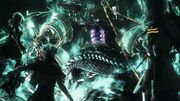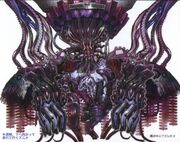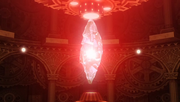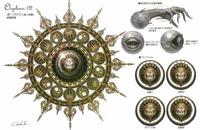The Maker created fal'Cie. And fal'Cie, in desperation to become reunited with the Maker, created l'Cie.
Vanille
The fal'Cie (ファルシ, Farushi?) [fæl'siː] are supernatural beings in the Fabula Nova Crystallis: Final Fantasy series. Their most prominent appearance is in Final Fantasy XIII and its sequels. They are ageless immortals who are often responsible for the creation and maintenance of the land where humans dwell, and indirectly govern their lives.
In the Famitsu magazine in June 2009, the fal'Cie were revealed to be formed from the crystals residing inside of them that act as their energy sources. The director of the game, Motomu Toriyama, described the fal'Cie as "god machines surrounding the crystals". In the interview with the Official PlayStation Magazine in August 2009, producer Yoshinori Kitase revealed there are various types of fal'Cie, their actual number being incalculable, although only a handful appear in Final Fantasy XIII.
Datalog

Titan, a Pulse fal'Cie.
Template:See Also Fal'Cie are an existence beyond human comprehension, possessed of incredible magic power. The ones responsible for Cocoon's construction are protectors of humanity, but there are others of their kind as well: the fal'Cie who dwell on Pulse and name themselves enemies of Cocoon.
Humans who encounter Pulse fal'Cie are cursed by being turned to l'Cie and ordered to destroy Cocoon. It is for this reason that most ordinary citizens support the Purge—anyone who may have come into contact with one of these fal'Cie represents a dire threat.
Template:See Also The Sanctum fal'Cie are the unfathomable entities that constructed the floating shell of Cocoon in ages past, and even now watch over the world's human inhabitants. Each is assigned a specific task that supports the existence of Cocoon's grateful populace, such as generating energy or manufacturing food. The fal'Cie rarely intervene directly in the governing of society, leaving that responsibility to appointed human representatives.
One theory states that, including the lower hierarchy, the total number of Sanctum fal'Cie exceeds eight million.
Mythos

The creation of Pulse and Lindzei.
In the official mythology the fal'Cie are said to be of divine origin. The god Bhunivelze, in his attempt to reach the world of the dead, created Pulse, Lindzei, and Etro. The mythology calls these three fal'Cie, but in the world of Final Fantasy XIII the humankind calls Pulse, Lindzei, and Etro gods and goddesses. After creating the three, Bhunivelze turned into crystal and entered a deep slumber.
Pulse and Lindzei were given powers to create and, according to the mythology, created many fal'Cie of their own: the Pulse fal'Cie and the fal'Cie that would create Cocoon. Etro was discarded, and in an act of self-loathing tore up her body and disappeared from the Visible World. Lindzei crafted humankind from Etro's body's remains and in time, humanity came to treat the fal'Cie as gods because of the variety of their actions: The Pulse fal'Cie terraform the land while the Lindzei fal'Cie offer to secure mankind's prosperity.
Pulse and Lindzei have the power to brand people chosen by their fal'Cie with the power of the crystals to make them fulfill special missions called Foci for them. These people, called the l'Cie, can be identified by a brand somewhere on their bodies. The appearance of the brand depends on the creator of the fal'Cie that chooses the l'Cie. The Pulse brands are an overlapping sequence of black arrows, while the Lindzei brands are the deity's crest.
Story
Final Fantasy XIII
Template:Sideicon

Pulse brands his l'Cie.
Pulse and Lindzei eventually left the world, leaving their fal'Cie orphaned. The Lindzei fal'Cie seek to summon back their Maker by isolating most of humanity into the artificial world of Cocoon, ruling it through the Sanctum while demonizing the Pulse fal'Cie who are still preoccupied with their directives. The Cocoon fal'Cie's use of propaganda incites a war between those who embrace the crafted paradise and those who remain on Gran Pulse to force a Pulse l'Cie to become Ragnarok and destroy Cocoon, with the resulting death count of millions forcing Etro's Gate to open, calling their creator back to the world.
While the first attempt during the War of Transgression failed due to Etro's divine intervention, the second almost succeeds in 0 AF at the cost of both Barthandelus, the leader of the Cocoon fal'Cie, and Cocoon's power source, Orphan. Vanille and Fang sacrifice themselves to build a crystal pillar to halt Cocoon's fall. With Orphan's death, Eden and the other Cocoon fal'Cie enter a dormant state and no longer sustain Cocoon.
Final Fantasy XIII-2
Template:Sideicon Even after the Catastrophe, many residents remain on Cocoon, and some push for the fal'Cie to be restored. Hope Estheim and the Academy create a man-made fal'Cie Adam, but when Hope learns from the Oracle Drive that Adam becomes sentient and repeats the actions of the Cocoon fal'Cie to rule Cocoon, he scraps the idea to sustain Cocoon with fal'Cie. Despite the fal'Cie on Cocoon having become dormant, the Pulse fal'Cie continue with their activities, apathetic toward Cocoon's fall and mankind's return to Gran Pulse.
Lightning Returns: Final Fantasy XIII
Template:Sideicon In the aftermath of the creation of Nova Chrysalia, the surviving fal'Cie have become dormant. Two fal'Cie can still be found in the Dead Dunes: an inactive Atomos is positioned above the entrance to a dungeon, while Titan has apparently been destroyed, his hand looming behind a dune and his head on top of another. The only remaining fal'Cie is Pandaemonium in Yusnaan's Warehouse District, which produces food for the inhabitants of Nova Chrysalia. Snow acts as its protector. There is also a Cactaur statue erected in homage to the fal'Cie Cactaur who journeyed with and protected Snow. During the final battle with Bhunivelze, beings similar to the fal'Cie Eden are summoned into battle. After the Apocalypse, the fal'Cie are presumed to have been destroyed.
Final Fantasy Type-0
Template:Sideicon There are two sets of beings equivalent to the fal'Cie of the Final Fantasy XIII universe. One is the demigod figures who watch, manage and maintain Orience during the repeated attempts to find the Unseen Gate: Arecia Al-Rashia, who serves the deity Pulse; Gala, who serves Lindzei; and Diva, who watches over both them and Orience. Arecia tries to use the potency of chosen souls to force the door open, while Gala, when the balance between Orience's nations is disrupted, uses his armies to slaughter the land's population to try and force the gate open. If the scheme fails, Gala chooses an avatar and instigates Finis to reset Orience and ready it for a repeat of the cycle.
The other type is the crystals of Orience: according to Hajime Tabata, they have a limited will, although they are little more than automatons. In earlier story drafts, they were referred to as "fal'Cie".[1] They were created by Arecia, as the people they brand as l'Cie bear the brand of Pulse. In the aftermath of the Arbitor of Lulusath's death, Arecia abandons the experiment when Class Zero rejects the choice to become l'Cie and changes the world's fate, allowing the students Machina and Rem to remember their past. Afterward, the crystals wane and the land rebuilds.
Final Fantasy XV
Template:Sideicon While not directly confirmed by the developers, concept art reveals fal'Cie to appear in Final Fantasy XV. The Goddess Etro was speculated to be one of them, although in Final Fantasy XV the fal'Cie and the gods/goddesses are not the same thing.
Known fal'Cie
Final Fantasy XIII
Lindzei fal'Cie
Lindzei's fal'Cie were created to maintain and protect Cocoon, which they proclaimed a utopia to lure humans into moving in. Despite being relied on by the citizens, the Cocoon fal'Cie are unsympathetic toward them and view them as tools to suit their needs as sacrifices. Due to their inability to deviate from their task to preserve Cocoon, the Cocoon fal'Cie manipulate the Pulse l'Cie to destroy Cocoon for them. After Orphan's death and the Catastrophe, the Cocoon fal'Cie became dormant and Cocoon deteriorates until it collapses in 500 AF.
- Orphan: Representing sunlight and in an unborn state, Orphan powers the other Cocoon fal'Cie via the fal'Cie Eden that acts as an intermediary.
- Eden: The fal'Cie responsible for monitoring all functions of Cocoon, whom Cocoon's capital is named after. Siphoning its power from Orphan, Eden communicates with a Sanctum representative and is believed to be the authority in Cocoon by its citizens.
- Phoenix: The fal'Cie in charge of Cocoon's weather, shining like a sun in the middle of Cocoon while overseeing numerous fal'Cie who manage the wind and rain.
- Carbuncle: Responsible for the production of food in Cocoon.
- Kujata: Provides Cocoon with power. It is based at the Euride Gorge and is the fal'Cie who made Dajh Katzroy into a l'Cie.
- Barthandelus: The Cocoon fal'Cie's leader who masterminds the events of Final Fantasy XIII in the guise of Galenth Dysley to ensure his kind's reunion with their Maker through Cocoon's destruction. Barthandelus is the fal'Cie who turned Cid Raines into a l'Cie.
- Menrva: Barthandelus's familiar and a living construct holding his power while he is in human form.
- Palamecia: The fal'Cie modified by the Sanctum to serve as PSICOM's airship.
- Leviathan: Provides Cocoon with purified water.
- Siren: It is unknown what this fal'Cie's function is, but it is located in a shrine in Bodhum and is briefly seen during a cutscene between Snow and Serah. It is a humanoid figure holding a wing-shaped harp. Although not named in-game, the Final Fantasy XIII Ultimania Omega guide identifies it as Siren.
- Protera: lifts and moves the Pulse Vestige from Bodhum. Its appearance is detailed in the Final Fantasy XIII Ultimania Omega where it is described as a "Shield fal'Cie". The Palamecia was carrying the Vestige at Hanging Edge.
Pulse fal'Cie
While some Pulse fal'Cie search for Etro's Gate through terraforming and observation, some become revered as patron deities in Gran Pulse villages, such as Anima of Oerba and the nameless fal'Cie of Paddra who became inactive for unknown reasons, despite still being able to enact its purpose to project images from the Oracle Drive. Unlike their Cocoon-based brethren, Pulse fal'Cie are mostly indifferent to human presence yet still brand them when the need arises. Most of Pulse fal'Cie remain active prior to the Catastrophe and after it some are either destroyed or become inactive. During the events of Lightning Returns: Final Fantasy XIII the Pulse fal'Cie appear to have become dormant, and are likely destroyed when the Apocalypse is triggered.
- Anima: Originally located in Oerba, it turned Vanille and Fang into l'Cie prior to being transferred to Cocoon where it entered hibernation. By the events of Final Fantasy XIII, Anima is reactivated as it turns Serah, Lightning, Snow, Hope, and Sazh into l'Cie.
- Atomos: A spherical fal'Cie who digs underground passages in Mah'habara Subterra before the events of Lightning Returns: Final Fantasy XIII where it remains immobilized within the Dead Dunes.
- Bismarck: Protects the Sulyya Springs; trespassers into the waters are eliminated.
- Titan: Forces an artificial selection process to produce more powerful species on Pulse. In Lightning Returns: Final Fantasy XIII, the remains of his body are scattered across the Dead Dunes.
- Dahaka: Based at Taejin's Tower, Dahaka roams about Gran Pulse's skies in search for Etro's Gate before Lightning's group enters its domain and destroys it.
- Fenrir: The largest of the Pulse fal'Cie, it causes century long eclipses whenever active in search for Etro's Gate. During Final Fantasy XIII-2, a paradox occurring at Oerba in 200 AF activates Fenrir in the year 10 AF, and the eclipse only affects the Yaschas Massif region.
- Cactuar: The fal'Cie responsible for Snow's second branding in Final Fantasy XIII-2. Along with Snow, Cactuar spends some time in the Sunleth Waterscape fighting the Royal Ripeness.
- Pandaemonium: The last remaining fal'Cie, residing in Yusnaan. It manufactures food for the population from Chaos itself, and is protected by Snow.
Proto fal'Cie

Concept art for scrapped fal'Cie "Nemesis", which appears to be the basis for Adam.
The Proto fal'Cie are man-made fal'Cie. To create them, humans use pieces of dormant fal'Cie and either rebuild them or duplicate the design, but the exact process used to create and sustain them is unknown. Proto fal'Cie bear the abilities of true fal'Cie, including the ability to brand humans as l'Cie and turn them into Cie'th.
In Final Fantasy XIII-2, to save Cocoon from its predestined collapse, the Academy devises the Proto fal'Cie Project in 13 AF to re-levitate the structure. The Proto fal'Cie Adam is a paradox by traveling through time to the Augusta Tower to program the AI to slaughter everyone and cover up the deaths with holograms and kill anyone who learns the truth while ensuring its creation. By 400 AF Adam repeats the actions of the Cocoon fal'Cie and rules over humans using the Academy's resources, but Noel and Serah erase Adam from existence by having Hope never complete the Proto Fal'Cie project.
Final Fantasy Type-0/Agito

The Suzaku Crystal.
While not appearing under the name "fal'Cie", the crystals of Orience and certain figures take their roles, maintaining the world, selecting people to become l'Cie and furthering the agenda of the Fabula Nova Crystallis deities. The crystals appear as semi-sentient objects of political power: there are four crystals, each held by a different nation of Orience. They erase the memories of the recent dead from the living, ensuring that painful memories do not hold the population back. Arecia Al-Rashia forged the crystals, and they have survived each successive cycle of war, healing themselves from any damage suffered in the process.
When the l'Cie Arbiter of Lulusath is destroyed by Class Zero, the crystals gradually lose their power and Machina unites Orience under one banner and utilizes alternative means of producing energy to sustain the land. In an alternative ending, Arecia is convinced to remove the crystals from Orience erasing the cycle of war. As revealed in the case of Ryid Uruk, the crystals cannot bestow their powers upon people of mixed heritage beyond a certain age.
- Arecia Al-Rashia: An immortal servant of the deity Pulse, who is thought to have created the crystals of Orience. She is the head of the magic division in Rubrum, shares a bond with Ace and is aided in her task by Joker and Tiz. She attempts to use the souls of Class Zero to find and open Etro's Gate.
- Gala: The leader of the Lulusath Army and servant of the deity Lindzei. Gala arrives when the balance between the nations is upset, and his army slaughters the population to force Etro's Gate open. Gala chooses Cid Aulstyne to be the l'Cie Arbiter of Lulusath. Despite killing himself, Cid's body is still used.
- Diva: The overseer of the world, charged with recording all events, including those pertaining to Arecia and Gala.[2]
- The Vermillion Bird Crystal: This holds and bestows the Power of Magic. The Vermillion Peristylium, based in the Dominion of Rubrum, is dedicated to refining the use of magic.
- The White Tiger Crystal: This holds and bestows the Power of Weapons. The people of the Milites Empire, through the White Peristylium, gain technological prowess, including the use of Magitek Armor.
- The Azure Dragon Crystal: This holds and bestows the Power of the Dragon. It allows the people of the Kingdom of Concordia to live in peace and harmony with the creatures.
- The Black Tortoise Crystal: This holds and bestows the Power of the Shield. The people of the Lorican Alliance are granted extra strength and robustness in comparison to the other countries.
- Palace of All Magic: The building housing the l'Cie Arbitor of Lulusath and the final dungeon of Final Fantasy Type-0.
Scrapped Fal'Cie
Six other fal'Cie were designed during the development of Final Fantasy XIII, but were scrapped:[3]
- Nemesis: Appears as a purple palette swap of Anima. Nemesis would have been a boss in the Seventh Ark and would fight similarly to Anima. This concept was later used for the Proto fal'Cie Adam in Final Fantasy XIII-2.
- Ramuh: A Pulse fal'Cie towering over the landscape, portrayed as an old man smoking a pipe.
- Gilgamesh: Wields swords of various sizes that dwarf large buildings.
- Squid fal'Cie: Planned to dwell in the Sulyya Springs.
- Diabolos.
- Garuda.
- The Lulusath Crystal: a fifth crystal of Orience subservient to Gala which was featured in early drafts of Final Fantasy Type-0.[4]
Gallery
Template:Gallery
Etymology
"Fal'Cie" is an anagram of ciel (French word for sky, from the Latin caelum), and "fa" in this context is derived from the Latin famulus, meaning "servant". When combined, the new name (famulus caelum) may translate to "Sky's Servant".
It is also possible that "fal'Cie" is a play on the word "fallacy", from the Latin fallācia, meaning "a deceptive, misleading, or false notion, belief, etc".
Apart from Barthandelus, Dahaka, Orphan, Menrva, Palamecia, Protera and Adam, each of the fal'Cie are named after summons from previous Final Fantasy games. Dahaka's Japanese name has been used on multiple occasions for common enemies, as has Barthandelus's. Adam and Eden are names from the Book of Genesis, although Eden is a summon in Final Fantasy VIII.
Trivia
- The datalog entry mentions "the total number of Sanctum fal'Cie exceeds eight million". This most likely means "countless" instead of literally eight million because the number eight often signifies large quantities in Japanese culture. Yoshinori Kitase has said in an interview the number of fal'Cie is "incalculable".
- In Dissidia 012 Final Fantasy, there is a battlegen in Orphan's Cradle called Fal'Cie Husk.
- When first seen in Academia at 400 AF, Adam has the same appearance as the Pulse Vestige that contained Anima in Final Fantasy XIII.
References
- ↑ http://type0.haloandwingsstudio.com/tabata/
- ↑ (2011-11-30) Final Fantasy Type-0 Ultimania (in Japanese), 790-793, Tokyo: Studio Bentstuff.Invalid citation format.
- ↑ Final Fantasy XIII'' Ultimania Omega, Final Fantasy 25th Anniversary Ultimania
- ↑ (2012-02-01) Final Fantasy Type-0 Artwork Book: Secret Vermillion History (in Japanese), 250–253, Tokyo: SQUARE ENIX.Invalid citation format.
Template:FNC Template:LSaga Template:FFXIII Template:XIII2 Template:LR Template:Type0 Template:FFXV




